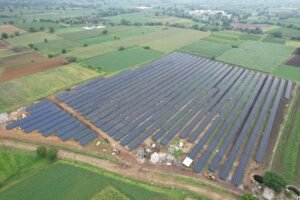New Delhi (Business Correspondent): India has achieved a new position at the global level by taking a big leap in the renewable energy sector. According to a recent report, India has become the third largest country in the world to produce electricity from wind and solar energy in 2024, with this achievement India has overtaken Germany. This information has come to light in the sixth annual report ‘Global Electricity Review 2025’ of global energy think tank ‘Ember’. According to the report, globally wind and solar energy contributed 15% of the total electricity generation in 2024, while India’s share was 10%. In India, 22% of electricity generation now comes from clean energy sources. In this, hydropower is contributing 8%, and wind and solar energy together contribute 10%. In 2024, India added 24 gigawatts (GW) of new solar power capacity, more than double the amount added in 2023. This growth has made India the third largest market for solar power after China and the US.
Solar power remains the largest energy source
Solar power remained the largest source of new electricity in the world for the third consecutive year. In 2024, solar added 474 terawatt-hours (TWh) of electricity, 49% more than in 2022. Solar power has also gained tremendous momentum in India. In 2024, the contribution of solar power reached 7% in total electricity generation, double that of 2021.
Clean energy dominates globally
The report also pointed out that 40.9% of global electricity generation in 2024 came from low-carbon sources (such as renewables and nuclear energy), which is such a large share for the first time since the 1940s.
India leads solar energy in Asia
Aditya Lola, Asia Director at Ember, said, “Electricity demand in Asia is growing rapidly and countries like India are playing an important role in leading clean energy in this.” Strong financial investment and policy support is needed to push this transformation in India. Nashvin Rodrigues, senior analyst, warned that if India is to achieve its renewable energy target of 500 GW by 2030, it will have to ensure at least 20% more investment every year.
UN support and India’s goal
UN Climate Change chief Simon Steele described India as a “solar superpower” and said that full adoption of clean energy can further accelerate India’s economic growth. India had set a target in its Nationally Determined Contribution (NDC) in 2022 that it will get 50% of its total electricity generation capacity from non-fossil sources by 2030. At the same time, India also announced an ambitious target of achieving 500 gigawatts of non-fossil capacity by 2030. This achievement of India shows that it is playing a leading role in the global energy transition. However, the challenge of increasing electricity demand and financial resources required for renewable energy projects still remains. If India maintains this momentum and strengthens investment, it will not only meet its climate goals on time but will also emerge as a decisive force in global clean energy leadership.









